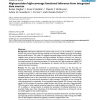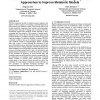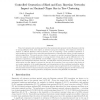721 search results - page 62 / 145 » Biological Network Inference Using Redundancy Analysis |
BMCBI
2008
14 years 10 months ago
2008
Background: Information obtained from diverse data sources can be combined in a principled manner using various machine learning methods to increase the reliability and range of k...
111
click to vote
BMCBI
2008
14 years 10 months ago
2008
Background: Structural analysis of biochemical networks is a growing field in bioinformatics and systems biology. The availability of an increasing amount of biological data from ...
132
click to vote
CLADE
2008
IEEE
15 years 4 months ago
2008
IEEE
With the exponential growth of complete genome sequences, the analysis of these sequences is becoming a powerful approach to build genome-scale metabolic models. These models can ...
101
click to vote
AI
2006
Springer
14 years 9 months ago
2006
Springer
This article presents and analyzes algorithms that systematically generate random Bayesian networks of varying difficulty levels, with respect to inference using tree clustering. ...
101
click to vote
KDD
2012
ACM
13 years 6 days ago
2012
ACM
Trust networks, where people leave trust and distrust feedback, are becoming increasingly common. These networks may be regarded as signed graphs, where a positive edge weight cap...



